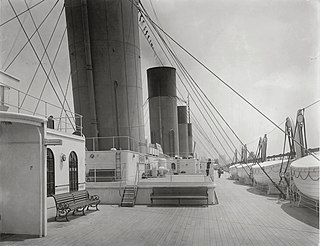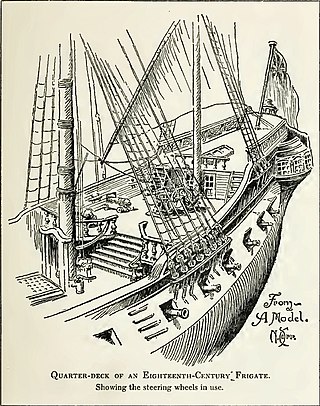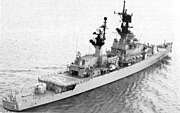
Shōkaku was the lead ship of her class of two aircraft carriers built for the Imperial Japanese Navy (IJN) shortly before the Pacific War. Along with her sister ship Zuikaku, she took part in several key naval battles during the war, including the attack on Pearl Harbor, the Battle of the Coral Sea, and the Battle of the Santa Cruz Islands, before being torpedoed and sunk by the U.S. submarine USS Cavalla at the Battle of the Philippine Sea.

The second USS Astoria (CL/CA-34) was a New Orleans-class cruiser of the United States Navy that participated in both the Battle of the Coral Sea and the Battle of Midway, but was then sunk in August 1942, at the Battle of Savo Island. Astoria was the first New Orleans-class cruiser to be laid down but launched after and received a hull number higher than the lead ship New Orleans.

A razee or razée is a sailing ship that has been cut down (razeed) to reduce the number of decks. The word is derived from the French vaisseau rasé, meaning a razed ship.

The forecastle is the upper deck of a sailing ship forward of the foremast, or, historically, the forward part of a ship with the sailors' living quarters. Related to the latter meaning is the phrase "before the mast" which denotes anything related to ordinary sailors, as opposed to a ship's officers.

The Type 12 or Whitby-class frigates were a six-ship class of anti-submarine frigates of the Royal Navy, which entered service late in the 1950s. They were designed in the early 1950s as first-rate ocean-going convoy escorts, in the light of experience gained during World War II. At this time, the Royal Navy were designing single-role escorts and the Whitbys were designed as fast convoy escorts capable of tackling high-speed submarines. However, this made the Whitbys more expensive and sophisticated to produce in large numbers in the event of a major war, and so the Type 14 "utility" or "second-rate" anti-submarine frigate was developed to complement the Type 12. Although themselves rapidly outdated, the Type 12 proved to be an excellent basis for a series of frigate designs used by the British and Commonwealth navies for the next 20 years.

The Clemson class was a series of 156 destroyers which served with the United States Navy from after World War I through World War II.

The Wickes-class destroyers were a class of 111 destroyers built by the United States Navy in 1917–19. Together with the six preceding Caldwell-class and following 156 subsequent Clemson-class destroyers, they were grouped as the "flush-deck" or "four-stack" type. Only a few were completed in time to serve in World War I, including USS Wickes, the lead ship of the class.

A deck is a permanent covering over a compartment or a hull of a ship. On a boat or ship, the primary or upper deck is the horizontal structure that forms the "roof" of the hull, strengthening it and serving as the primary working surface. Vessels often have more than one level both within the hull and in the superstructure above the primary deck, similar to the floors of a multi-storey building, that are also referred to as decks, as are certain compartments and decks built over specific areas of the superstructure. Decks for some purposes have specific names.
This glossary of nautical terms is an alphabetical listing of terms and expressions connected with ships, shipping, seamanship and navigation on water. Some remain current, while many date from the 17th to 19th centuries. The word nautical derives from the Latin nauticus, from Greek nautikos, from nautēs: "sailor", from naus: "ship".

An escort destroyer was a small warship built to full naval standards which was optimised for air-defence and anti-submarine duties in wartime, but which retained many of the capabilities of a traditional fleet destroyer, enabling it to conduct operations in conjunction with main fleet units as well as carrying out convoy escort and ASW patrols. Typically, escort destroyers had a high enough speed and sufficient armament of guns and torpedoes that they were capable of skirmishing successfully with enemy destroyers and cruisers.

The quarterdeck is a raised deck behind the main mast of a sailing ship. Traditionally it was where the captain commanded his vessel and where the ship's colours were kept. This led to its use as the main ceremonial and reception area on board, and the word is still used to refer to such an area on a ship or even in naval establishments on land. Many such facilities have areas decorated like shipboard quarterdecks.

The Fubuki-class destroyers were a class of twenty-four destroyers of the Imperial Japanese Navy. The Fubuki class has been described as the world's first modern destroyer. The Fubuki class set a new standard not only for Japanese vessels, but for destroyers around the world. They remained formidable opponents to the end of World War II, despite being much older than many of their adversaries.

The first USS McCook (DD-252) was a Clemson-class destroyer in the United States Navy. Entering service in 1919, the ship had a brief active life before being placed in the reserve fleet. Reactivated for World War II, the ship was transferred to the Royal Navy and then to the Royal Canadian Navy and renamed HMCS St. Croix. Assigned as a convoy escort in the Battle of the Atlantic, St. Croix was torpedoed and sunk on 20 September 1943.

The Caldwell class was a class of six "flush deck" United States Navy destroyers built during World War I and shortly after. Four served as convoy escorts in the Atlantic; the other two were completed too late for wartime service. Two were scrapped during the 1930s, but four survived to serve throughout World War II, three of these in service with the Royal Navy under the Destroyers for Bases Agreement and the fourth as a high speed transport.

The Farragut-class destroyers were a class of eight 1,365-ton destroyers in the United States Navy and the first US destroyers of post-World War I design. Their construction, along with the Porter class, was authorized by Congress on 29 April 1916, but funding was delayed considerably. Limited to 1,500 tons standard displacement by the provisions of the London Naval Treaty of 1930, the ships were laid down beginning in 1932 and were completed by 1935. After 12 years since the last of the previous class of American destroyers was commissioned, the Farraguts were commissioned in 1934 and 1935.

USS Murphy (DD-603) was a Benson-class destroyer in the United States Navy during World War II. She was named for Lieutenant John McLeod Murphy.
The two Tone-class cruisers were the last heavy cruisers completed for the Imperial Japanese Navy. The Tone-class cruisers were originally envisaged as the 5th and 6th vessels in the Mogami class. However, by the time construction began, serious weaknesses in the Mogami-class hull design had become clear following the Fourth Fleet incident in 1935. As Japan no longer was obligated to abide by the limitations of the London Naval Treaty, a new design was created and new means of construction were utilized. Although the external dimensions were close to the Mogami class, the design was quite different, with all the main battery of guns placed forward of the bridge, reserving the entire stern area as a large seaplane operations deck. Unlike the U.S. Navy, the Japanese did not have a dual role attack/scout aircraft, nor did they assign any of their carrier aircraft to a reconnaissance role. Little emphasis was placed on this aspect of carrier warfare. Instead the Japanese reserved all of their carrier aircraft for attack roles. Reconnaissance then was relegated to the float planes carried by cruisers. The Tone and the Chikuma were intended to provide the long range reconnaissance needed for Japan's carrier Air Fleets.

The aircraft cruiser is a warship that combines the features of the aircraft carrier and a surface warship such as a cruiser or battleship.

In traditional nautical use, well decks were decks lower than decks fore and aft, usually at the main deck level, so that breaks appear in the main deck profile, as opposed to a flush deck profile. The term goes back to the days of sail. Late-20th-century commercial and military amphibious ships have applied the term to an entirely different type of hangar-like structure, evolving from exaggerated deep "well decks" of World War II amphibious vessels, that can be flooded for lighters or landing craft.




















